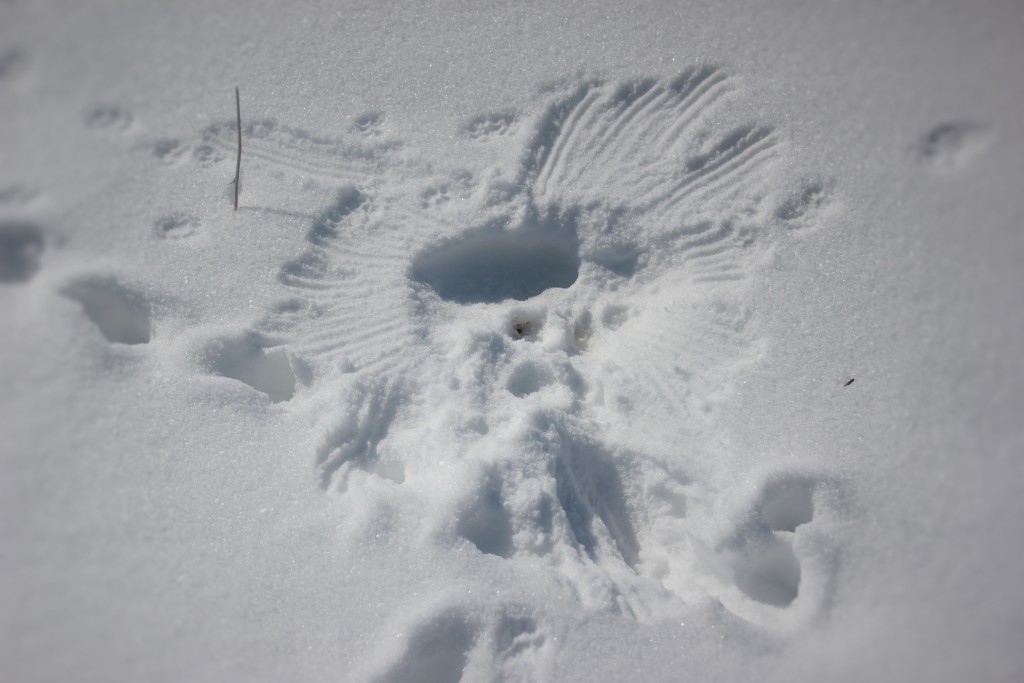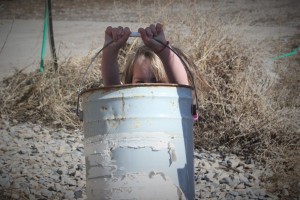
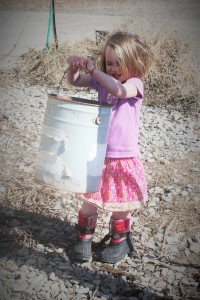
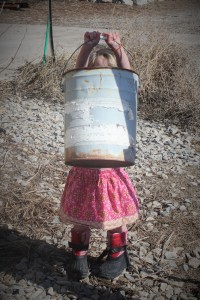
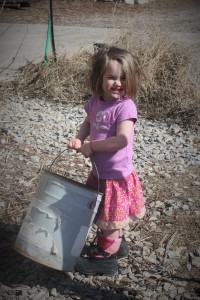
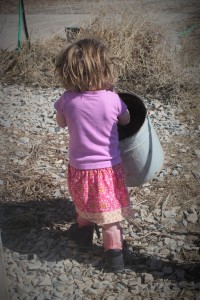
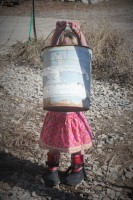
Many (little) Hands Make Light Work











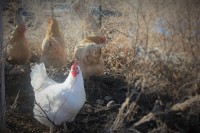
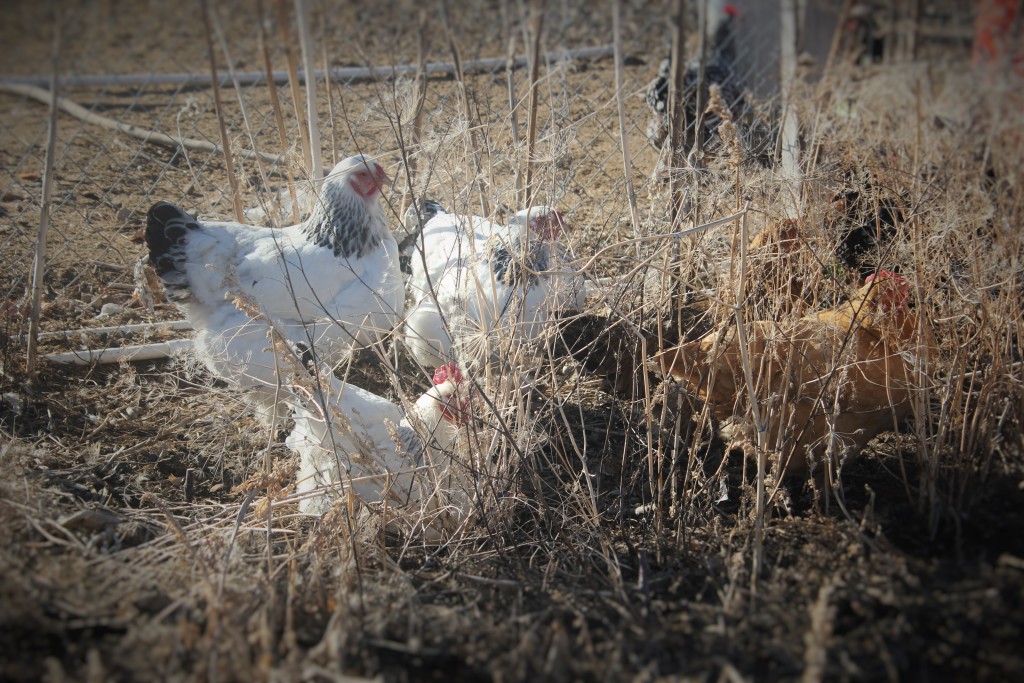
Scratching around the dill patch, eating old seeds, bugs and new seedlings. Soon they will be fenced out of this area, but for now they can enjoy the forage and we have the benefits of their scratching and manure to fertilize.
Our chickens at Quail Run Farm are free range all year long. At nights we close them in a coop to protect them from predators, but every morning the coop doors are open wide for our girls to explore and feast on fresh grasses and bugs, the natural diet of chickens. In the winter the girls tend to stick very close to home, they don’t like walking in the snow, so they either hang out in the coop or under the coop where they have shelter. When the days start getting longer and warmer, and the snow starts to recede the girls get adventurous again range widely across the farm, enjoying the new fresh grass, a welcome variety to their normal winter ration.
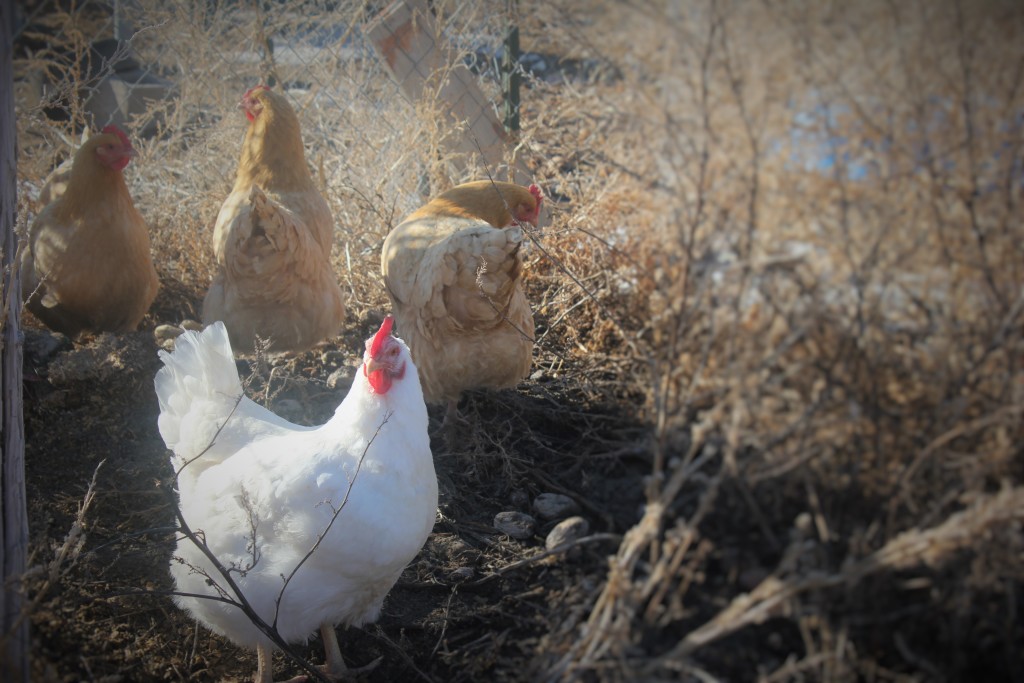
Working hard turning the compost pile for me, eating bugs, worms and old seeds.
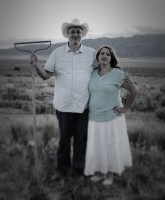
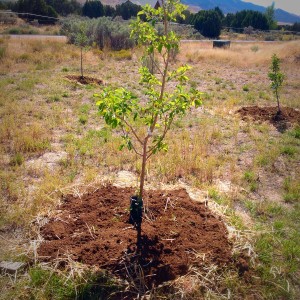
“I know of no pursuit in which more real and important services can be rendered to any country than by improving its agriculture, its breed of useful animals, and other branches of a husbandman’s cares.” – George Washington (July 20, 1794)
There has been a growing trend in the US and around the world. I think that we are all starting to adapt the philosophy of Hobbits, and have a “love for things that grow.” There are a lot of homesteading books, blogs, and facebook pages that have surfaced over the last few years. We are also seeing a growing number of people that are turning to self reliance, prepping, food storage, and preparing for the unexpected.
I think we have also been caught up in this at Quail Run Farm. We are being drawn to the Earth, to the magic of making things grow, and the feeling of accomplishment that agriculture can give. We are being drawn to teach our children how to grow, tend, and productively use the land. In doing so, we have done a lot of research and study. You are going to see several different terms used on this blog, and in writings from Quail Run Farm. The goal of this post is to give you a basic understanding of some of the terms we use. Terms like Permaculture, Hugelkultur, No Till Gardening, as well as Drop Dead Swales. I hope that after reading this post, you will have enough of an understanding to know what each of these terms mean as you continue to follow our journey.
Our basic goals. There are a couple of rules, or guidelines that we like to follow at Quail Run Farm. There are several things that are crucial to agriculture and farming. The first is Water. You can’t grow things unless you have water, and you do what you can to conserve and use that water to the best of your ability. The second is soil fertility. You can have all the water you need, but if you don’t have enough fertility in the soil to encourage and sustain growth, you will not win the battle. So, we are trying to find ways, techniques, and procedures that will help us use and find water, while we build up the fertility of the soil. In the process we also want to be good stewards of the land, so we try to have everything we do and plant have more than a single goal or benefit.
Permaculture
Permaculture is a term that is used often when you read about homesteading and gardening these days. Basically, permaculture is defined as agriculture that is based on the principles observed in the natural ecosystem. It is the philosophy of working with nature, rather than against it. It is a philosophy that includes ecological design, ecological engineering, environmental design and construction. It is looking at integrated water resource management as well as sustainable engineering. This is a huge topic, and I have only give you a very high overview, you can get more details from sites like permacultureprinciples.com. Instead of removing and forcing the land, it is the philosophy of using nature and working with it instead of expecting nature to go away and be tamed.
Hugelkulture
This is a topic that I find fascinating. Basically the principle of a Hugelkulture is to create a growing area that absorbs water, as well as increases the soil fertility. A Hugelkulture is a bunch of woody organic material that is then covered with soil. The woody material then absorbs water, stores it, and then slowly releases it into the soil. In the process, the woody material breaks down and increases the fertility of the soil. We use sunflower stocks, old Christmas tree trunks, and other material in our Huglekultures. We also put ash from our wood burning stove, manure, and other green matter in them as we build them to help increase the soil fertility. The majority of our Huglekultures I would consider Drop Dead Swales, I will go into more detail on that later.
Here is an example of a Hugelkulture bed.
Eventually, over the years, the bed will break down and increase the soil fertility and store water.
Drop Dead Swales
The majority of the huglekultures that we have built are what I would call a Drop Dead Swale. Basically it is a trench that has been dug in the ground. The dirt is piled on the down hill side of the trench. The trench is then filled with woody and green matter. Then the dirt is raked over the trench to fill it. This accomplishes a couple of things. First, it creates a level area on the slope of the hill that you can then use to plant things on. That level area also slows down the water run off so that it can then collect in the swale. Second, it creates a pocket for run off water to collect. That water is then absorbed by the woody material. As the soil dries the water is then released back into the soil. Third, it increases the soil fertility as the green and woody material breaks down over time.
Here is an example of one of these Drop Dead Swales that I created for our grey water system, and a place to plant our bamboo.
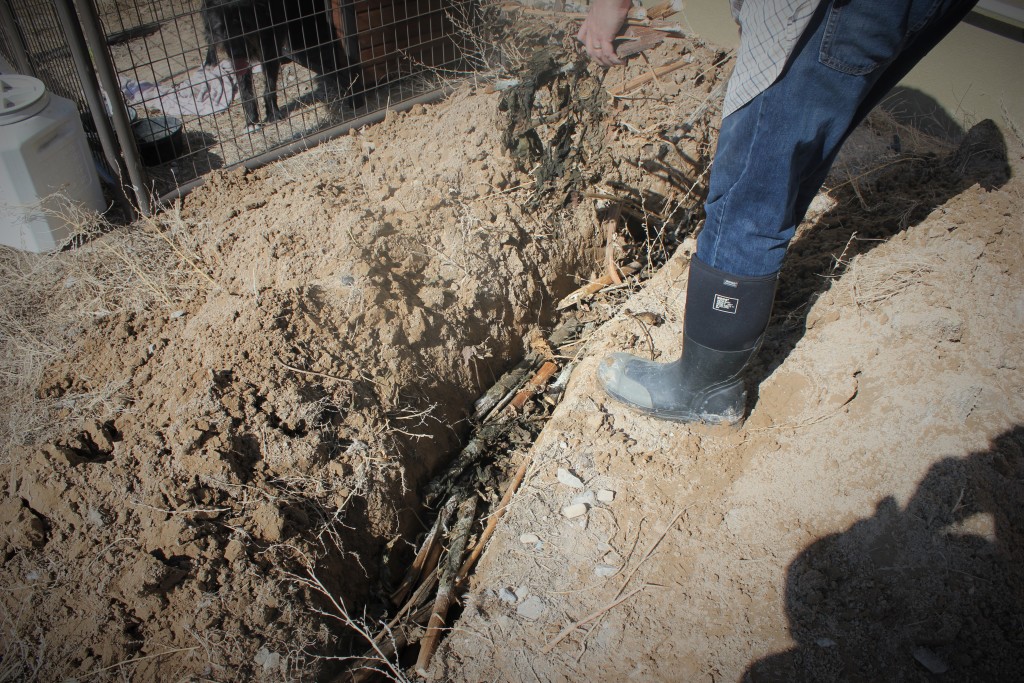 The theory is that as the water runs off into the trench, it is absorbed by the woody material, and then is stored for the plants to use. We have created a number of these around our property. We are using them to control run off from our house, as well as change areas to support plants that require more water. We have them in our orchard, as well as using them to grow Bamboo, and Asparagus. When we put in our peach orchard, we will be using them extensively around the peach trees to keep the water we do put on the trees in place and to protect that water from evaporation and run off.
The theory is that as the water runs off into the trench, it is absorbed by the woody material, and then is stored for the plants to use. We have created a number of these around our property. We are using them to control run off from our house, as well as change areas to support plants that require more water. We have them in our orchard, as well as using them to grow Bamboo, and Asparagus. When we put in our peach orchard, we will be using them extensively around the peach trees to keep the water we do put on the trees in place and to protect that water from evaporation and run off.
No Till Gardening
The theory behind No Till Gardening is to disturb the land as little as possible. There are areas where we can do this, and areas where it is not possible. But the basic principle is, you plant your plants, without tilling the ground. Then as your plants grow, you return their green matter back to the area that they were grown in. An example would be as you weed around your plants, you just drop the weeds back on the ground around the plants. This is supposed to accomplish a couple of things. First, you are not disturbing the ground and allowing more weeds to grow. Second, you are putting the nutrients from the green matter back into the ground. Third, the weeds create a mulch that helps retain water. Basically, instead of digging up the ground and putting the green matter under ground, you are building up the soil on top of the old ground. As you place mulch around your plants, you conserve water, increase soil fertility, and discourage weed growth. There are a lot of sites on the web that explain it better. http://www.no-dig-vegetablegarden.com/no-till-gardening.html
We may change or modify how we implement these over the course of the years. But the basic goal we have is to preserve and use water wisely, increase the fertility of the soil as we use the land, and work with nature and have it help us meet our goals instead of fight it.
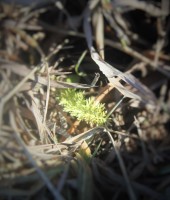
The weather on the farm has been really mild the last week after a very cold, very snowy winter season. The air is moist, full of melting snow and the ground is saturated with water. It’s an interesting time of year, an interesting feeling to the air, being in the high desert typically the air and ground is dry, except in the early spring as old man winter and jack frost make their retreat and the lady of springtime moves in. Water drips, drips, drips off the eves of the house and runs into collection barrels, or collects in swalls and hugelkulturs, making the ground soft and the mud deep. Shallow puddles collect here and there in small depressions in the ground, a tease for soon the long dry summer season will be upon us.
On of my very favorite early spring activities is playing hide and seek with the earliest of my green ones, just making their very first ventures into the mild spring air. They taunt and dare the hard freezes to come back and the snows to cover them, knowing that while there may be an attempt, the strong army of winter has retreated and will bow to the freshness of spring. I’m always amazed, that under blankets and drifts of hard cold snow, life quietly sleeps waiting for its moment.
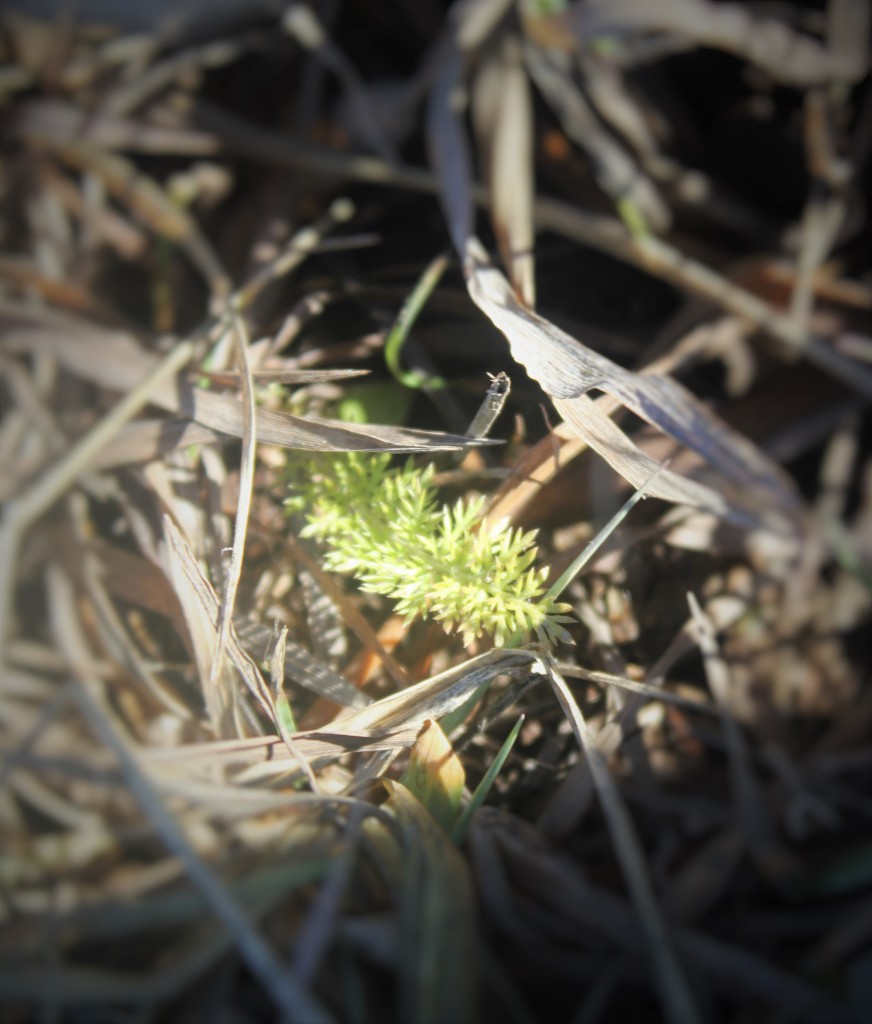
My baby Yarrow, her blooms will grace my meadow this summer and my tea cup next winter
Today I took a stroll in my orchard meadow, this little project has a special little place in my heart. It is where we have planted a variety of fruit trees creating fertility around them, not only by spreading composted material, but planting beneficial herbs, flowers and grasses at their feet. Most of my medical herbs are there, and a huge juniper tree that I lovingly call “The Mother Tree” presides over my orchard meadow, it is a place of healing, a place growing, fertility, birth and magic. I carefully looked among the roots of my darling fruit trees searching for the first signs of life, of my little herbs that are gathering strength and stretching out of a deep sleep. I was not disappointed. I found the soft feathery leaves of chamomile, the broad green of plantain, the tiniest leaves of yarrow that I had babied all last season, and of course the bold spears of daffodils making their first appearance.
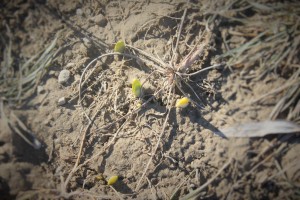
Bold Daffodil, these are the first spears of about two hundred bulbs planted in the meadow, we will soon have to watch our step.
I love the first quiet days of spring, before the heavy work of preparing bed and planting seeds starts, when the world wakes up and beckons me to come watch a while.
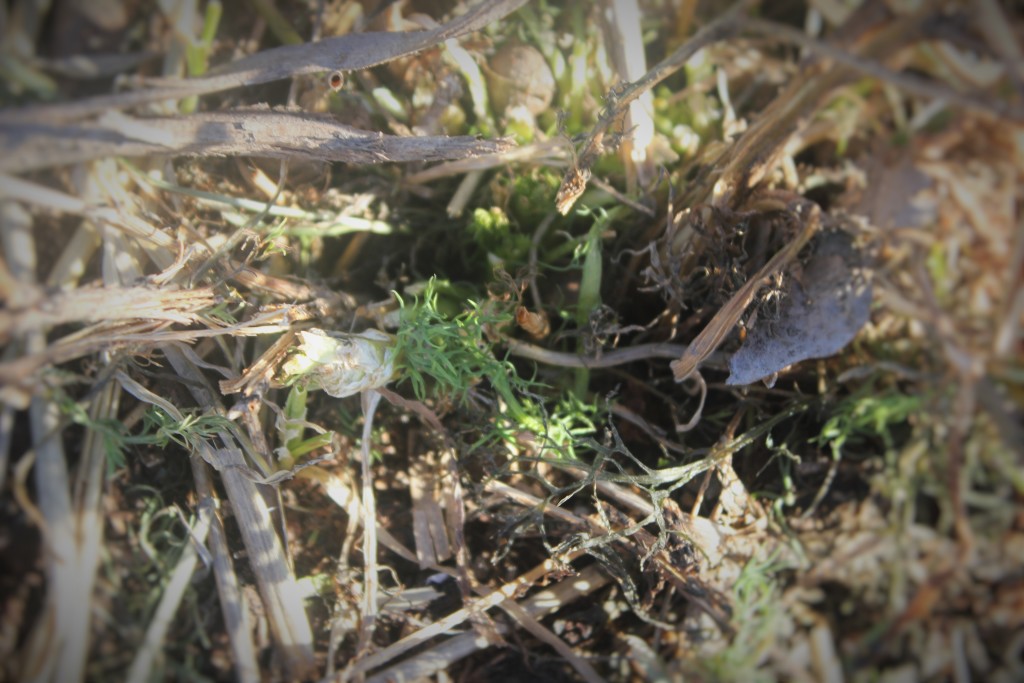
Chamomile, was only sleeping under its blanket of snow at the foot of an apple tree
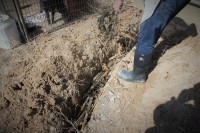
On the farm this next year, we want to start growing Bamboo. We want to use it in several ways. It will help filter our grey water, provide shade for the south side of the house, and give us materials to use for our bean poles and pea poles. Not to mention that it would be cool to be raising and growing bamboo in the middle of the high desert in Utah.
To help get ready for the bamboo, we installed our grey water system (or the beginning of it). We moved our bee hives out of the area and put them farther out on the property. And we have started getting the area ready for planting the bamboo.
One of the things we were able to start over the weekend was to build the series of Hugelkulturs to retain the water from the grey water system, as well as build up the soil for the bamboo. I was able to build two of the four that we are going to put in the area.
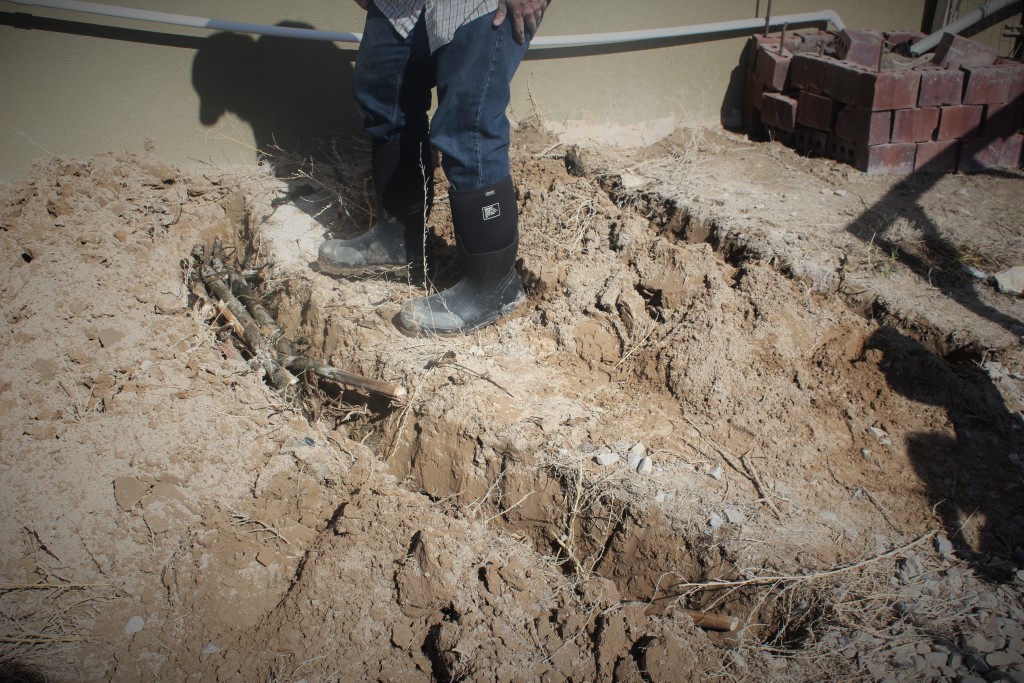 I started by digging out several ditches. I had Tom help me out with the digging. He used his scout shovel that he got from Christmas. It is basically a scout/military travel shovel that allows you to modify it so that the shovel has several different angles you can dig at.
I started by digging out several ditches. I had Tom help me out with the digging. He used his scout shovel that he got from Christmas. It is basically a scout/military travel shovel that allows you to modify it so that the shovel has several different angles you can dig at.
 We then filled the trench in with a bunch of old sun flower stocks that were given to us by a relative. I then also took one of the buckets we use to collect the ashes from our wood burning stove and poured the ashes in the trenches as well. We then covered the trenches with dirt.
We then filled the trench in with a bunch of old sun flower stocks that were given to us by a relative. I then also took one of the buckets we use to collect the ashes from our wood burning stove and poured the ashes in the trenches as well. We then covered the trenches with dirt.
Like most things we do on the farm, we usually try to get as many little hands to help as possible. Our two little girls help by putting the sun flower stocks in the ditch. And of course, you can’t work on the farm as a little girl unless you do it in fluffy skirts.
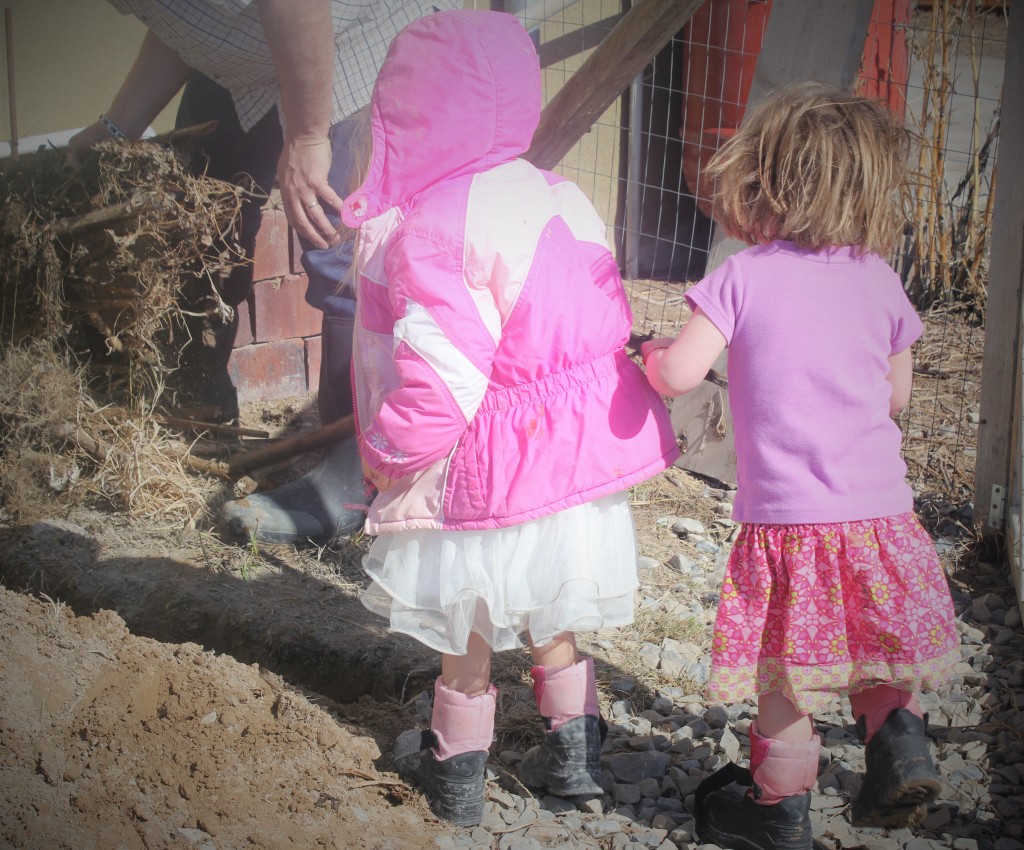
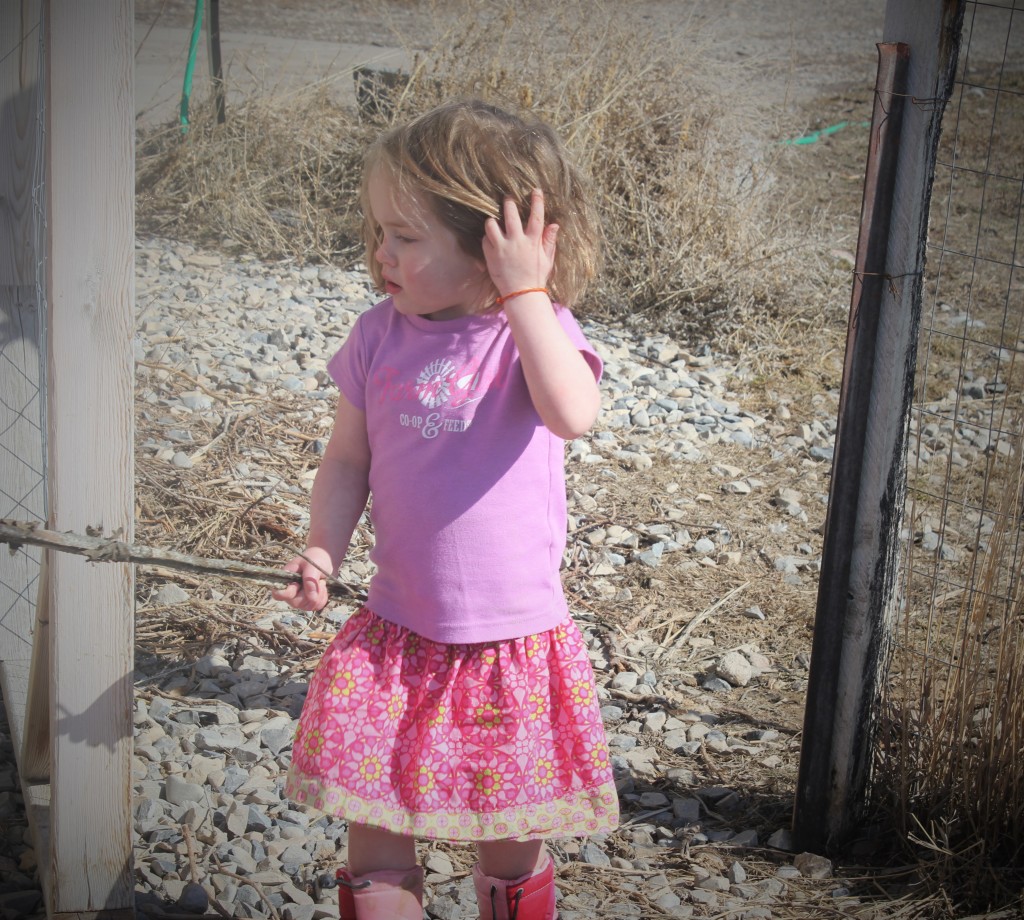
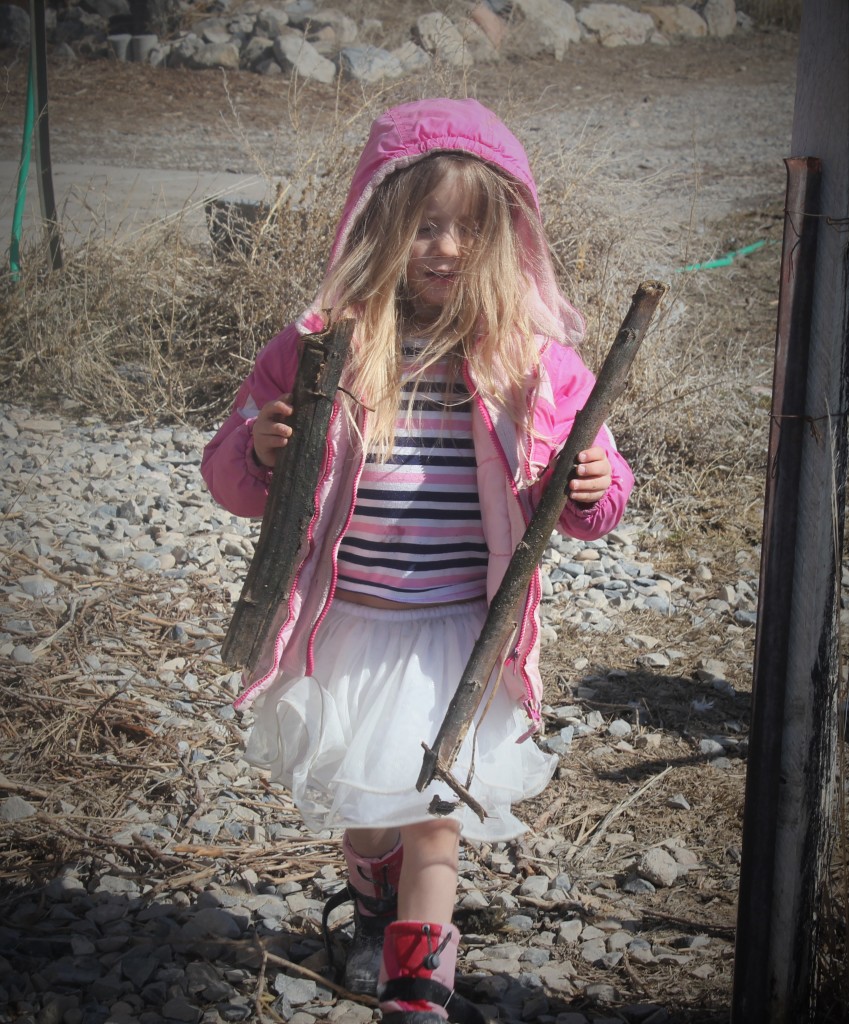 Snow boots and all. I really do enjoy working on the farm, and spending time with the kids as we build, grow, and work the land.
Snow boots and all. I really do enjoy working on the farm, and spending time with the kids as we build, grow, and work the land.
I also ordered the Bamboo. There are a bunch of places it can be ordered from on the internet, but I found a place on amazon that sells two of the three varieties we want to try. Here is what we have purchased so far, and we are excited to give it a go.
This is Phyllostachys Auerosulcata
This is Phyllostachys Bissetii
In the future, I will probably buy from Bamboogarden.com. I picked amazon this time around because of the pricing. We are going out on a limb, and the least amount of money I can spend at this point the better. If what we buys winters over well, I will buy a larger number from several different vendors. They were very helpful in helping pick the variety of bamboo that would work in the area we are planning on growing it.

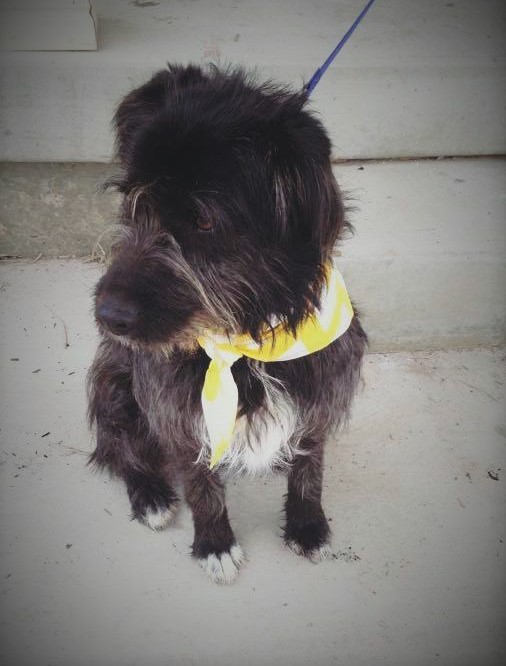 We got a dog. Her name is Tippy and we have pretty much fallen in love with her, deep, deep love. We’ve wanted a dog for a while. We thought it would be fun for the kids, and we felt a need to have a livestock guard dog, just to keep the ‘yotes and raccoons away. When we first moved to the farm we got a puppy and it ended up badly, we learned that we are not good puppy owners and that we didn’t have enough time to properly train a dog to be around livestock, so I had put the idea of a dog out of my mind, figuring that the right dog would come around when the time was right….and it did.
We got a dog. Her name is Tippy and we have pretty much fallen in love with her, deep, deep love. We’ve wanted a dog for a while. We thought it would be fun for the kids, and we felt a need to have a livestock guard dog, just to keep the ‘yotes and raccoons away. When we first moved to the farm we got a puppy and it ended up badly, we learned that we are not good puppy owners and that we didn’t have enough time to properly train a dog to be around livestock, so I had put the idea of a dog out of my mind, figuring that the right dog would come around when the time was right….and it did.
Tippy came from my uncle who has a cattle ranch and has working dogs. Tippy was brought to the ranch for that purpose, to help work cattle, but proved to be too timid. However, she was so obedient, loving and great around kids, perfect for a small farm and family with kids, perfect for us! She has been with us for almost a week and it seems like she has been here the whole time. She blends right in, she is great with the animals, comes when calls, likes to chase cats a bit too much (but the cats are showing her who is boss), chases jack rabbits, enjoys long walks and loves the kids so much. We are so happy to welcome Tippy to the farm!
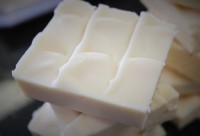
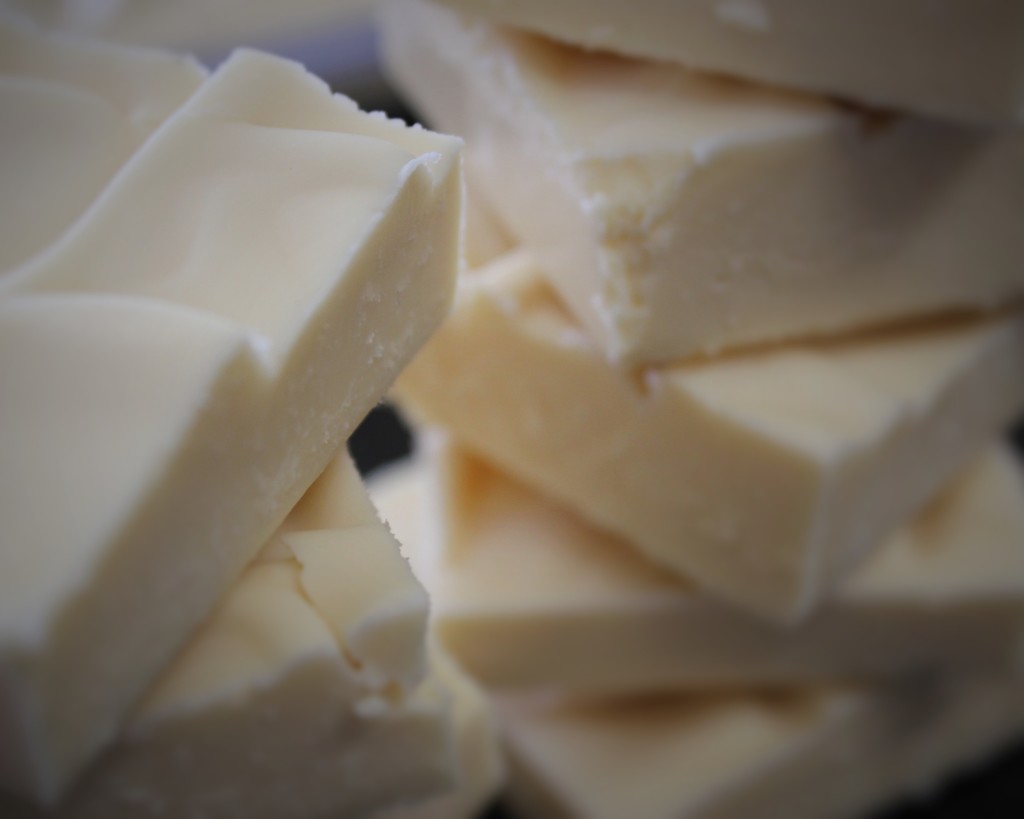
Goat Milk soap, newly un-molded and cut, ready to be moved into the curing room
I have made our own soap off and on for about seven or eight years now. It was one of the first projects I tackled when I decided that I wanted to learn the lost arts of homemaking. There were a few bad batches, some lye burns and wasted oils, but at the end of it all I discovered a craft that I love and isn’t too common (unless you look on etsy, then it seems like everyone makes and sells soap). I made it for our home and occasionally for family and friends. A few months ago, after a bit of a break I took up the craft again, but this time I really started to experiment with different scents and herbs.
I think I have found my art.
I love crating new flavors of natural soaps, using only the best ingredients. Making soap is a mix of many loves: the botanical world, natural living, lost homemaking skills and serving others. I enjoy experimenting with different herbs and essential oils to make lightly scented soaps that are gentle and nourishing for the skin as well as the soul. I believe when you use natural ingredient when caring for our homes and bodies it imparts a bit of the spirit of the plant into the space its serving. In a world full of artificial, petroleum derived objects, “foods” and self care items, bringing a part of the wild, natural world sooths our frazzled souls and imparts beauty and peace into our environment. I put a lot of myself into my soaps and I pray that when people use them, especially those I love, that they will feel the spirit in which it has been crafted.
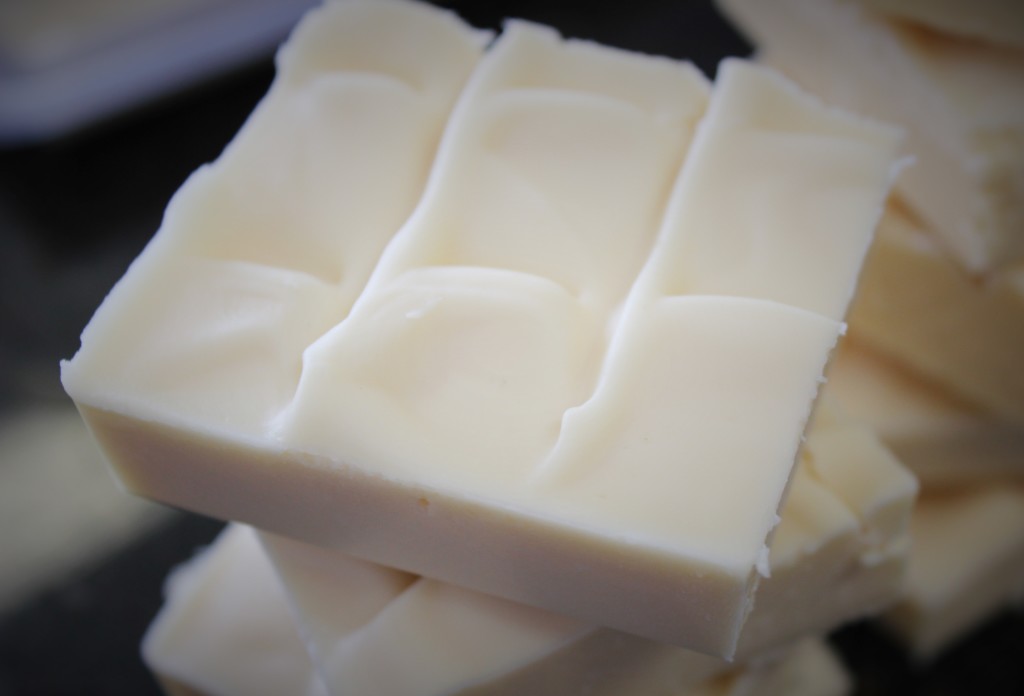
Goat Milk soap
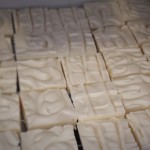 Goat Milk soap curing |
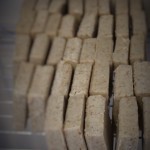 Juniper and Cedarwood soap curing |
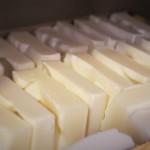 Tea Tree soap curing |
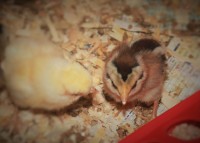
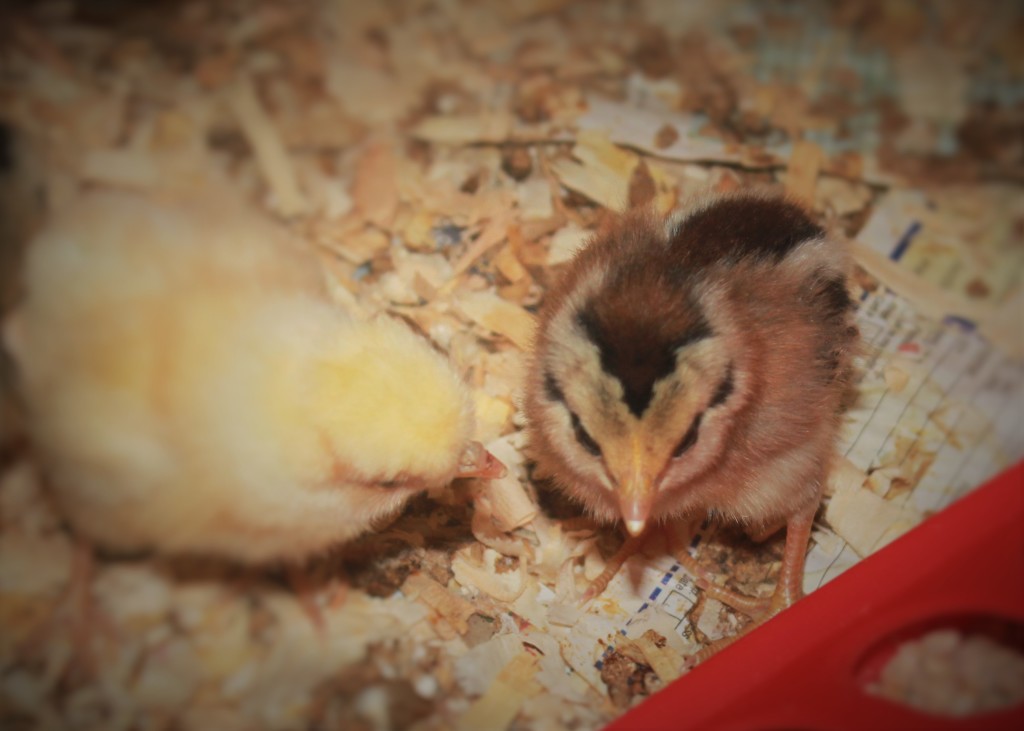
About two weeks ago we received our first order of chicks from the hatchery. When we got them home we realized that twelve of the chicks we ordered weren’t there, it seems the hatchery wasn’t able to hatch enough of this particular chick. We got a credit with the hatchery and ordered more, I want at least thirty six new chicks for the farm this year so we can up our egg production. Seems there is a demand for farm fresh eggs and I can sell every single egg I produce. In the meantime something was wrong with the chicks that did arrive. In the first two days we lost half of our little flock. They were earing and drinking fine, then they would get lethargic and die within about an hour or so. It was really strange, we aren’t new at this baby chick thing, we’ve been ordering and caring for them for years now and while I expect a few losses early on I had never seen this type of loss. After a quick call to the hatchery (they seemed to think it had to do with stress during shipping, or they got too chilled during shipping) we soon had twelve more chicks added to the order I had placed to replace the chicks that we didn’t receive in the first place (clear as mud?).
This morning I got the call that my chicks were at the post office waiting to be picked up! When I got them home I added them to the brooder with their big sisters, hoping that it wouldn’t be a problem, sometimes adding new chickens to an established flock can be troublesome, but so far the big sisters are doing great, even letting the little ones huddle under their wings for warmth!
Yay for forty eight new chicks! I can’t wait for them to start laying this summer!
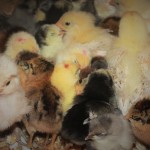
Little sisters mingling with the big sisters
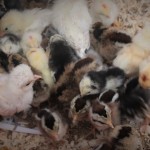
Little sisters huddling under the big sisters to get warm
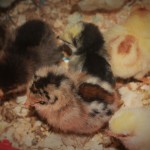
My little fluffies exploring the brooder
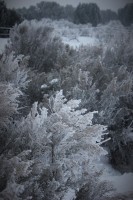
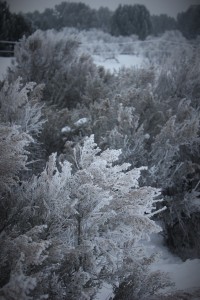 One of the things that I have learned on this Earth, is that every climate, every place has some type of beauty if you just look for it. This is just one example. A lot of people think that the desert has nothing to provide. It is hard to grow things, the wildlife can seem dull. But if you slow down, look around and enjoy what you find, you will see that almost anywhere on the Earth you can see beauty, majesty, and wonder. In the right conditions, even sage brush, juniper trees, and metal fence lines can turn into a work of art. (I personally think that sage brush, juniper trees, and metal fences always hold their own beauty.)
One of the things that I have learned on this Earth, is that every climate, every place has some type of beauty if you just look for it. This is just one example. A lot of people think that the desert has nothing to provide. It is hard to grow things, the wildlife can seem dull. But if you slow down, look around and enjoy what you find, you will see that almost anywhere on the Earth you can see beauty, majesty, and wonder. In the right conditions, even sage brush, juniper trees, and metal fence lines can turn into a work of art. (I personally think that sage brush, juniper trees, and metal fences always hold their own beauty.)
Last night the weather got pretty cold. The fog rolled in this morning, and with that combination, you can get some pretty cool frost growths on trees, plants, and fence lines. Here are some pictures I took this AM while walking around, and enjoying the sights, sounds, and cold temps of desert.
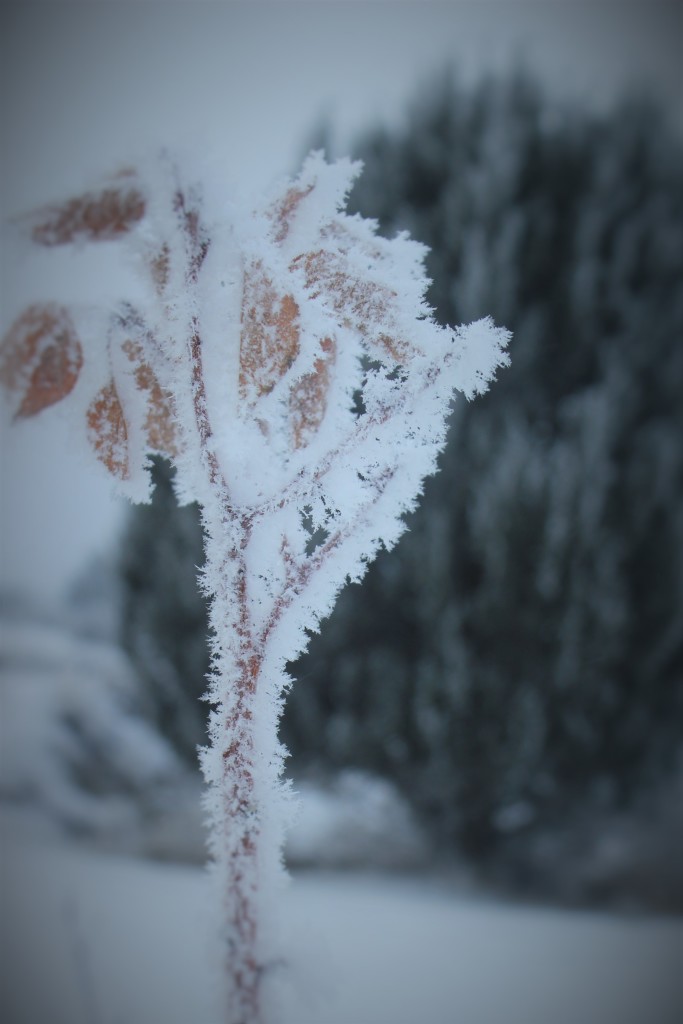
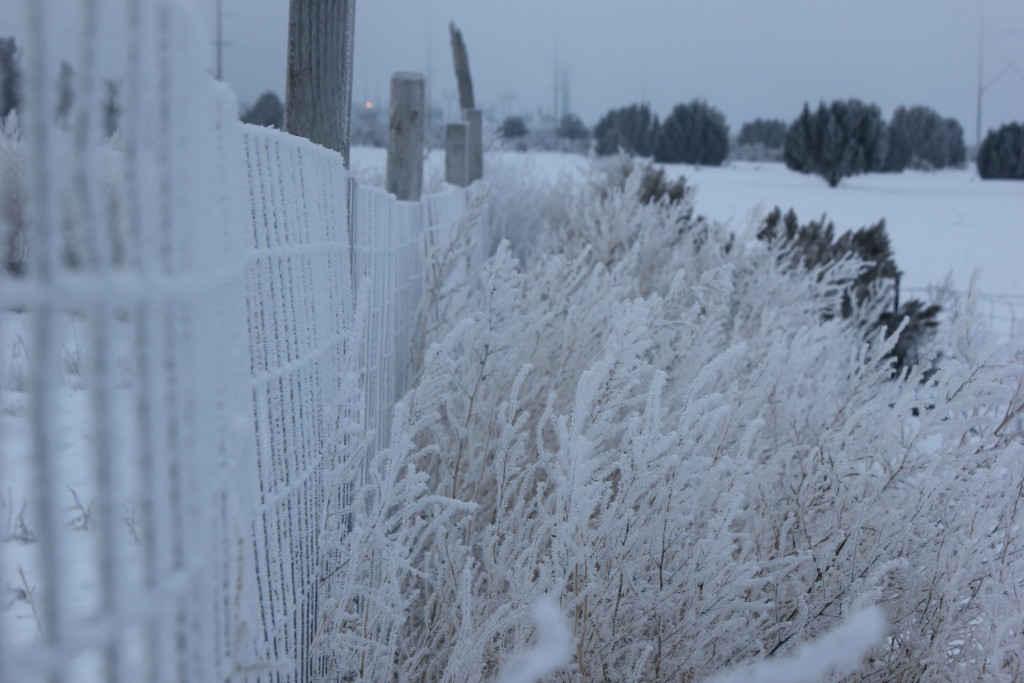
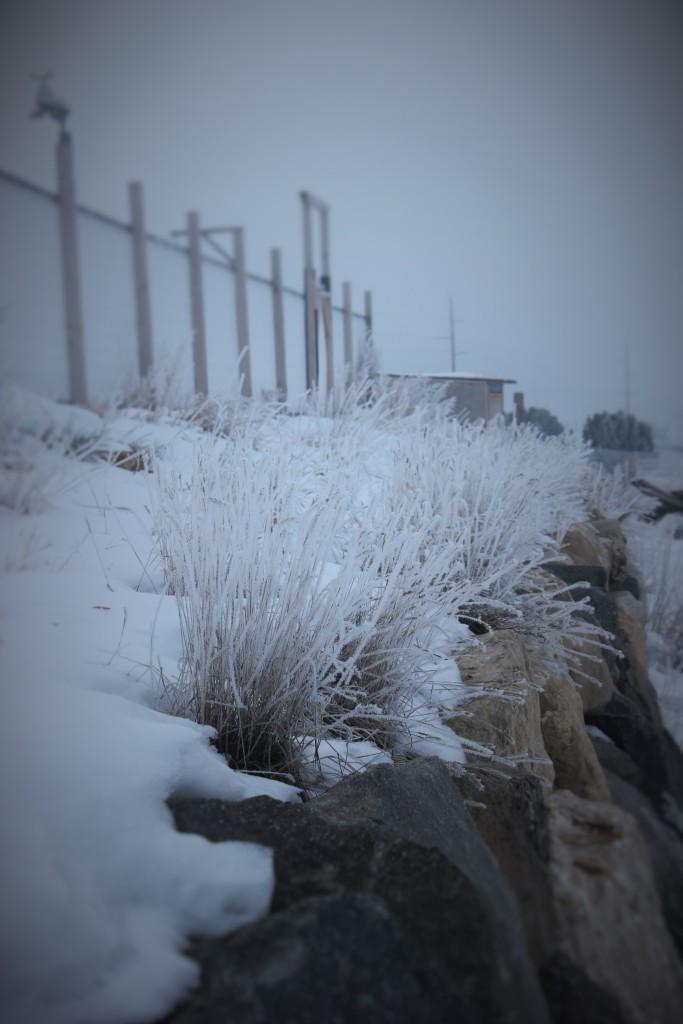
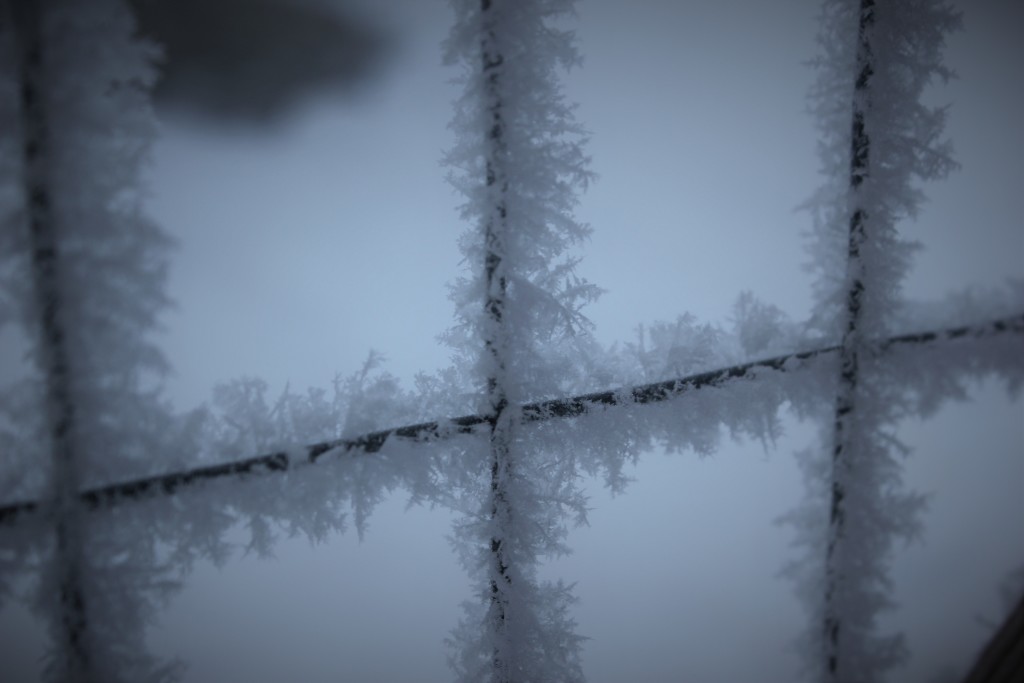
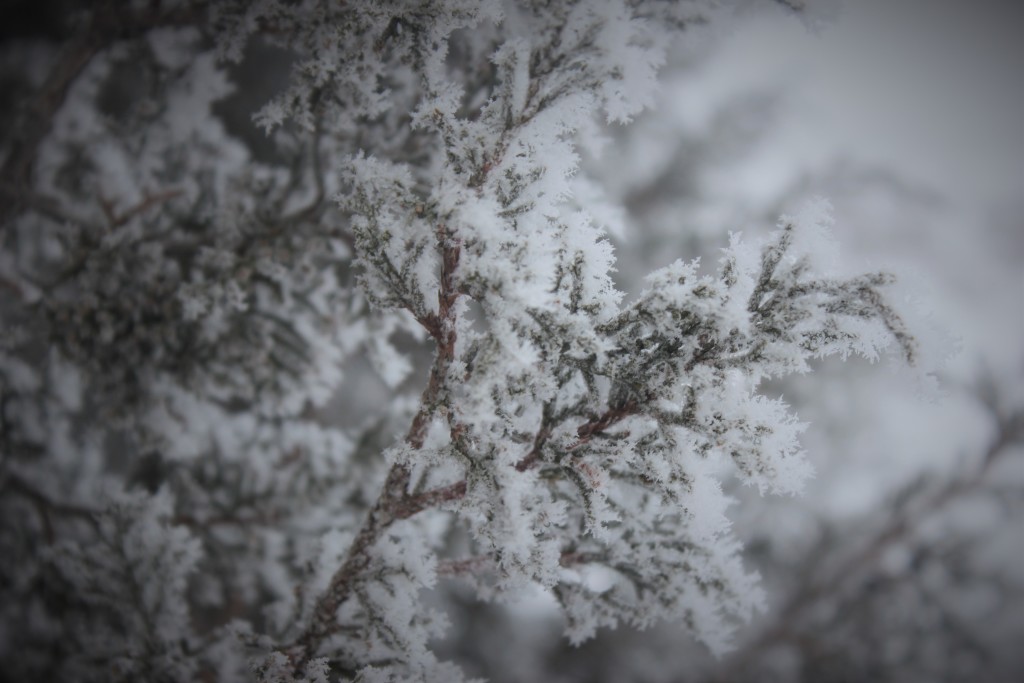
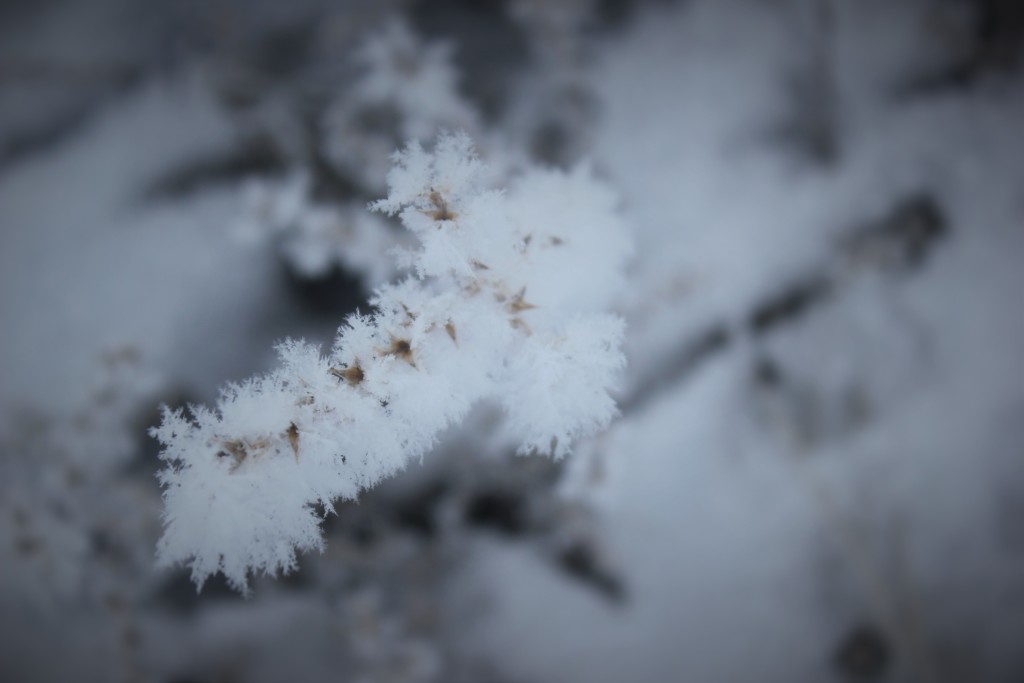
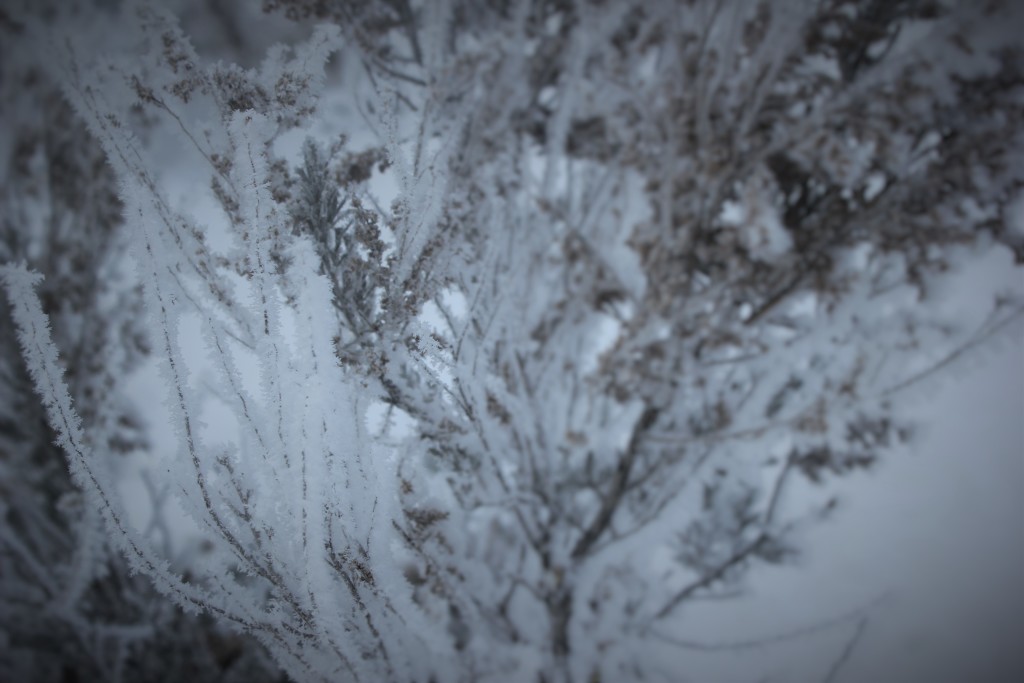
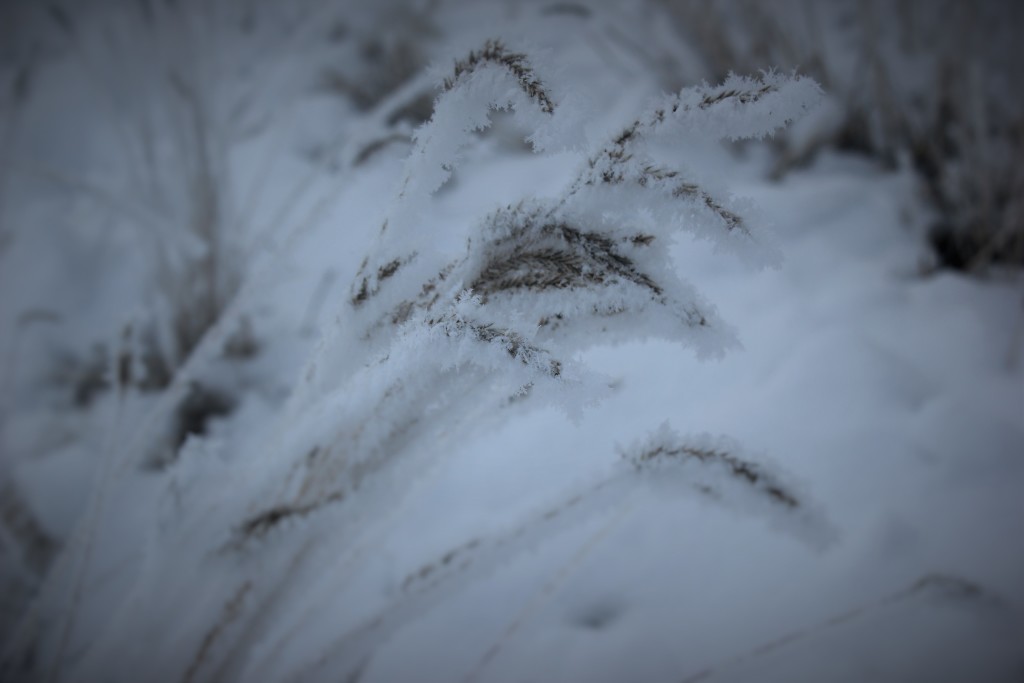
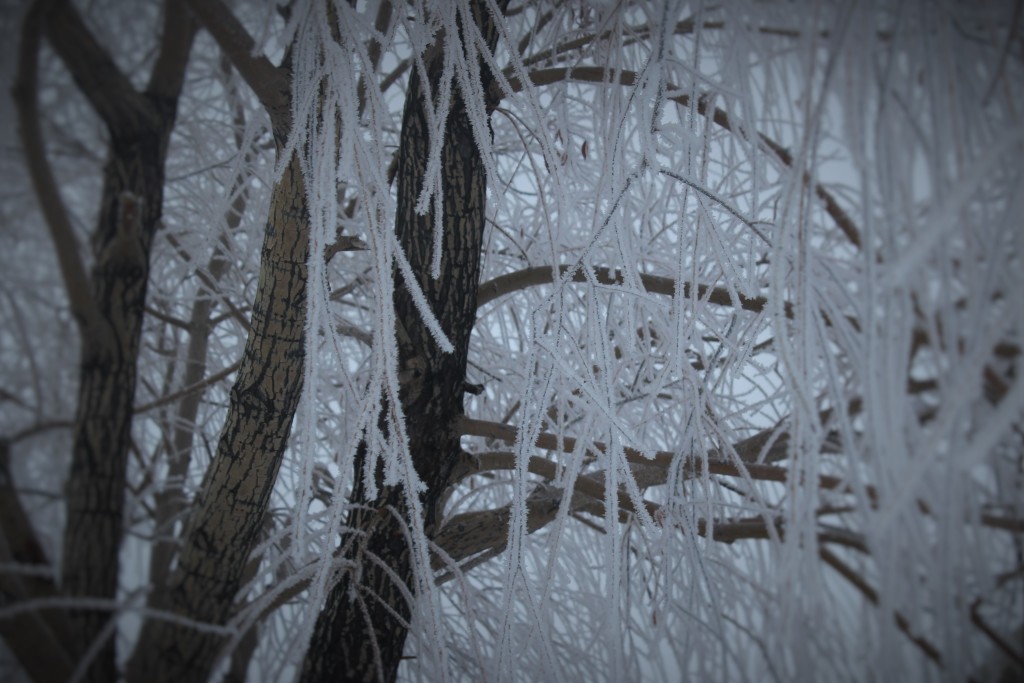
No matter where you find yourself. Take some time, sit back, and enjoy what is around you. Something as annoying as fog and cold weather can make the world a pretty place, if you just take the time to enjoy it.
For the geek in you that is wondering how frost crystals grow, and what makes them, you can check out this site: http://www.its.caltech.edu/~atomic/snowcrystals/frost/frost.htm It is a guide to different types of frost and their formations. What do you think, do we have examples of Surface Hoar, Frost Flowers, or maybe Rime Formations?
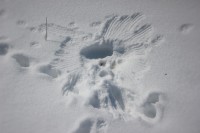
We found this interesting print in the snow. Anyone what to venture a guess at what created it? There were no tracks leading to or from it. The cat tracks round it look like there were there before the bird print, by several days.
